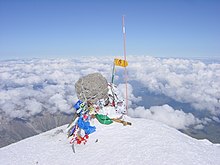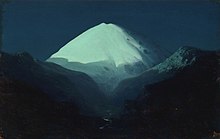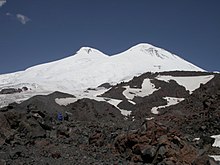Mount Elbrus
![]()
The title of this article is ambiguous. For other meanings, see Elbrus (disambiguation).
pd3
pd5
Template:Infobox Mountain/Maintenance/BILD1
Mount Elbrus (Russian Эльбрус Elbrus; Karachayo-Balkarian Минги тау Miñi tau [mɪˈŋːi taw], Kabardian Ӏуащхьэмахуэ [ʔʷaːɕħamaːxʷa]) is the highest peak in the Caucasus and the highest mountain in Russia, at 5642 m above sea level. Whether it or Mont Blanc (4810 m) should be considered the highest mountain in Europe depends on the definition of the Inner Eurasian border, for which there is no universally binding definition.
The double-peaked mountain (west peak height 5642 m, east peak height 5621 m) is a dormant, heavily glaciated volcano whose last eruption was 2000 years ago, but which is still classified as active. The distance between the two peaks is 1500 meters. The slightly lower eastern peak has a well-preserved crater about 250 meters in diameter. 22 glaciers flow from the Elbrush slopes into the valley and cover 145 km² with ice.
Name and mythology
The present name Elbrus probably derives from the Georgian word for "cone-shaped mountain" (Georgian იალბუზი Ialbusi). The variants Elboros, Elborus and Elburus were also used until the early 20th century.
Arrian mentioned in a report in Greek addressed to Emperor Hadrian about his round trip along the coasts of the Black Sea (Greek Períplous toû Euxeínou Póntou) that he could see the Caucasus during the trip to Dioskurias (today Sochumi). While there, he was said to have been shown a peak called Strobilos, to which, according to legend, Prometheus was chained by Hephaistos. Although it is not clear which Caucasus peak Arrian was referring to, some scholars and researchers have come to believe that Strobilos, or Latinized Strobilus, was the name of Mount Elbrus, including the mountaineer and geographer Douglas Freshfield in his work on the Caucasus (1896). The identity of Strobilus and Elbrus is also occasionally claimed in more recent times.
According to legend, Noah's Ark was stranded here for a short time before landing on Mount Ararat.
The Divs, Persian demons (cf. Daeva), are said to have been banished to Mount Elbrus as punishment for their sins and to have lived here ever since. Since it was seen as a holy mountain, an ascent was considered taboo for a long time.
The mineral elbrusite, a representative of the garnet group, was named after Mount Elbrus.
Geography
Mount Elbrus is located in southern Russia, about eleven kilometers north of the Georgian border, about 270 km as the crow flies northwest of the Georgian capital Tbilisi and 100 km west of the Kabardino-Balkarian capital Nalchik. The border between the Russian Caucasus republics of Kabardino-Balkaria and Karachay-Cherkessia runs across the western peak of Mount Elbrus, with most of the mountain massif in Kabardino-Balkaria.
The question of its attribution to Asia or Europe is controversial. There is the view that the main ridge of the Great Caucasus forms the inner Eurasian border, which would mean that Elbrus, which lies slightly north of the ridge, belongs to Europe. The other view, widespread especially in the German-speaking world, places the border with Asia according to Philip Johan von Strahlenberg (1676-1747). Strahlenberg was commissioned by the tsar's house to survey the land and moved the previously valid border of Europe from the Don River in a southeasterly direction to the Manytschniederung north of the Caucasus. According to this view, Mount Elbrus would be Asian.
With its assignment to Europe or Asia, the question of the highest mountain in Europe is also related. In mountaineering circles, Mount Elbrus is considered the highest mountain in Europe and thus belongs to the Seven Summits.

On the summit of Mount Elbrus

Archip Iwanowitsch Kuindschi: The Elbrus, 1890-1895 (oil on canvas)

Double summit of Elbrus, seen from the summit station of the second section of the Elbrus cableway
Search within the encyclopedia